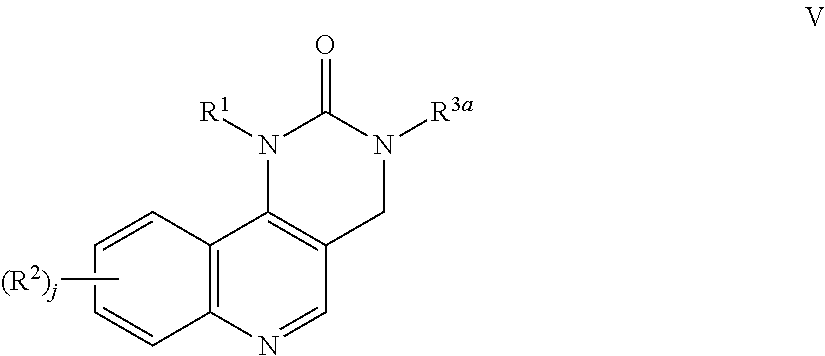Soluble mtor complexes and modulators thereof
a technology of mtor complexes and complexes, which is applied in the field of small molecule inhibitors of mtorc1 and mtorc2, can solve the problems of hampered efforts to discover mtor inhibitors using cell-based screens
- Summary
- Abstract
- Description
- Claims
- Application Information
AI Technical Summary
Benefits of technology
Problems solved by technology
Method used
Image
Examples
example 1
[0342]
Ethyl-6-chloro-4-oxo-1,4-dihydroquinoline-3-carboxylate
[0343]
[0344]A mixture of 4-chloroaniline (156.7 mmol) and ethyl ethoxymethylenemalonate (156.7 mmol) was stirred at room temperature until homogeneous. The homogeneous solution was heated in an oil bath at 165° C. for 6 hours. The reaction mixture was cooled to room temperature and 1 N HCl (3 mL) was added. The reaction mixture was stirred and heated to 115° C. for 3 hours. The mixture was cooled to room temperature and then treated with 20 mL of water. The resulting suspension treated with 10 N NaOH solutions to reach the pH about 8. It was partitioned between ethyl acetate and water. The organic layer was separated and the aqueous layer was extracted with ethyl acetate. The combined organic extracts were washed with brine, dried over MgSO4, filtered and concentrated. The crude product was purified by flash column chromatography using a 9:1 v / v hexane:ethyl acetate as solvent to afford title compound (28 g, 71% yield) as ...
example 2
[0361]
[0362]Tert-butyl 4-(4-(9-chloro-2-oxo-2H-[1,3]oxazino[5,4-c]quinolin-1(4H)-yl)-2-(trifluoromethyl)phenyl)piperazine-1-carboxylate. To a solution of tert-butyl 4-(4-(6-chloro-3-(hydroxymethyl)quinolin-4-ylamino)-2-(trifluoromethyl)phenyl)piperazine-1-carboxylate (407 mg, 0.75 mmol) in dichloromethane (10 mL) at 0° C. was added triphosgene (225 mg, 0.75 mmol) and Et3N (125 μL, 0.9 mmol). The resultant solution was allowed to warm up to room temperature and continued to stir for 4 h before being quenched with a satd. aqueous sodium bicarbonate (10 mL), extracted with EtOAc (3×20 mL), and dried over Na2SO4. After removal of the solvent in vacuo, the residue was purified by flash column chromatography to afford the title product (57%) as colorless oil. LC-MS: (M+H)=563.26
[0363]Tert-butyl 4-(4-(3′-(hydroxymethyl)-3,6′-biquinolin-4′-ylamino)-2-(trifluoromethyl)phenyl)piperazine-1-carboxylate. To a solution of tert-butyl 4-(4-(9-chloro-2-oxo-2H-[1,3]oxazino[5,4-c]quinolin-1(4H)-yl)-2-...
example 3
[0366]
[0367]Tert-butyl 4-(4-(6-chloro-3-((methylamino)methyl)quinolin-4-ylamino)-2-(trifluoromethyl)phenyl)piperazine-1-carboxylate. To a solution of tert-butyl 4-(4-(6-chloro-3-(hydroxymethyl)quinolin-4-ylamino)-2-(trifluoromethyl)phenyl)piperazine-1-carboxylate (400 mg, 0.74 mmol) in dichloromethane(10 mL) at room temperature was added MnO2 (2 g). The resultant solution was stirred for 3 h before filtering through celite and washing with dichloromethane (20 mL). After removal solvent in vacuo, the residue was redisolved in THF (5 mL), to which NaBH(OAc)3 (443 mg, 2.1 mmol) and CH3NH2.HCl (140 mg, 2.1 mmol) were added. The solution was stirred at room temperature overnight, quenched with NaHCO3 (sat. 10 mL), extracted with EtOAc (20 mL×3), and dried over Na2SO4. After removal of solvent in vacuo, the crude product was taken to next step without further purification. LC-MS: (M+H)=550.32
[0368]Tert-butyl 4-(4-(9-chloro-3-methyl-2-oxo-3,4-dihydropyrimido[5,4-c]quinolin-1(2H)-yl)-2-(tri...
PUM
 Login to View More
Login to View More Abstract
Description
Claims
Application Information
 Login to View More
Login to View More - R&D
- Intellectual Property
- Life Sciences
- Materials
- Tech Scout
- Unparalleled Data Quality
- Higher Quality Content
- 60% Fewer Hallucinations
Browse by: Latest US Patents, China's latest patents, Technical Efficacy Thesaurus, Application Domain, Technology Topic, Popular Technical Reports.
© 2025 PatSnap. All rights reserved.Legal|Privacy policy|Modern Slavery Act Transparency Statement|Sitemap|About US| Contact US: help@patsnap.com



